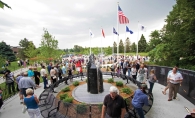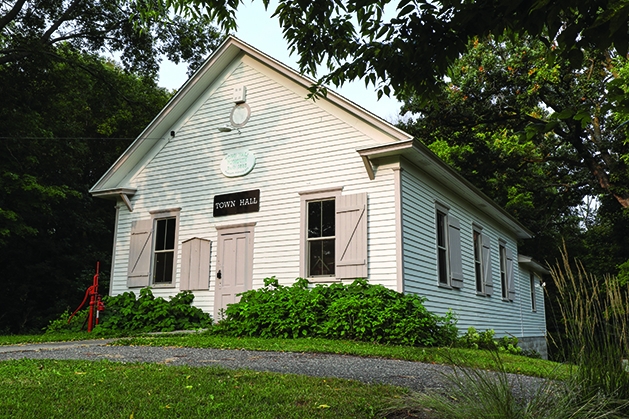
When I asked the Plymouth Magazine editorial advisory board for their Best of Plymouth picks, the topic many returned to was the great public resources in and around Plymouth. From places that nurture learning to those outfitted for play and exploration,
I considered all the public resources and facilities I’d been learning about through my position as editor of Plymouth Magazine, and I wanted to dig deeper.
I started out by contacting Rebekah Coffman, manager of the Plymouth Historical Society, to learn more about the history behind some of Plymouth’s most valuable resources. Pre-COVID-19, Coffman says the Historical Society used to lead bus tours around sites of note in the community. For our purposes, I want to share what I’ve learned by taking us on a (metaphorical) historical bus tour of our own, through a history of Plymouth that starts in its pre-European past and brings us up to the present day. We’ll start with our departure point at the Plymouth Historical Society itself.
Plymouth Historical Society
“The Plymouth Historical Society started out of community members’ impetus to preserve the city’s first town hall,” Coffman says. Built in 1885, the modest white frame building with its fieldstone foundation served as the center for Plymouth’s government through the 1950s. But by the 1970s, Coffman notes that the building had fallen into disrepair. “The Society worked to preserve the town hall building and expanded it through an additional upper-level room, excavated a finished basement level and repurposed it for use as a museum,” Coffman says.
This building now houses the Plymouth Historical Society’s vast collection of artifacts, most of which date back to the 19th century and early 20th century. Coffman notes that the collection historically placed an emphasis on Euro-American settlers in the area, but she’s interested in reflecting a wider lens of the various people and cultures that have called Plymouth home. “We are taking ongoing steps through archival research and programming to expand these stories,” Coffman says.
Some of the modern programming that’s expanding Plymouth’s historical narrative includes an oral history and mapping project, as well as the society’s themed virtual open house events. But even a few decades back, researchers working with the Plymouth Historical Society found ways to capture different facets of Plymouth’s past. One such research project, conducted and written by Roberta Laidlaw and Megan Lynch in 1995 and provided through the Historical Society’s archives, brings us further back in time to our first stop: Clifton E. French Regional Park.
Clifton E. French Regional Park
Laidlaw and Lynch note that while information about the park’s namesake (the park district’s first superintendent Clifton E. French) is widely available, “There is a real void of information concerning the past history of the area.” Through a combination of written and oral histories, the two aimed to provide an account of Plymouth that extended even further back than the initial 1848 visit of scout Antoine LeCount.
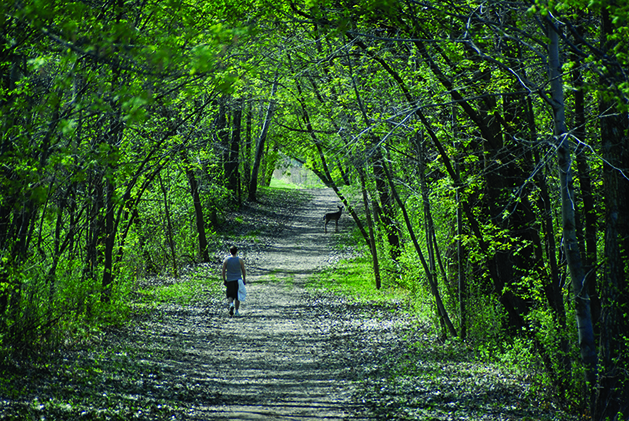
According to the earliest written histories available, from 1780 to 1853 the present-day park site was home to the Mdewakanton band of the Dakota tribe. When the French-Native American scout LeCount first arrived to the area, Laidlaw and Lynch note that there were no roads except those used by the Dakota people living in the area. LeCount built the first log cabin on the eastern shores of Medicine Lake in what is now French Regional Park and was joined by 36 other settlers by 1855.
Plymouth grew to a small farming community by the late 1850s, and Laidlaw and Lynch track the ownership of the park through plat maps from 1873 and 1898. In 1927, the Union City Mission of Minneapolis started buying land in the area to create Mission Farms. This “Christian camp,” as it was called by the locals, initially served as a rehabilitation program for homeless men from the Gateway district in Minneapolis. One descendent from early settlers, Ed Schiebe, who worked at Mission Farms during the Great Depression, recalled how people used to camp in teepees in the woods. Now, those woods form part of French Regional Park.
Plymouth Library
From the Great Depression of the 1930s, our tour picks up steam with the 1955 incorporation of Plymouth as a village and our next stop, the Plymouth Library, starts its story four years before Plymouth assumed the status of a statutory city in 1974. Cathy Fischer, first library manager for Plymouth Library and current board president of the Friends of the Plymouth Library, shares the origin of what is now the busiest library in Hennepin County.
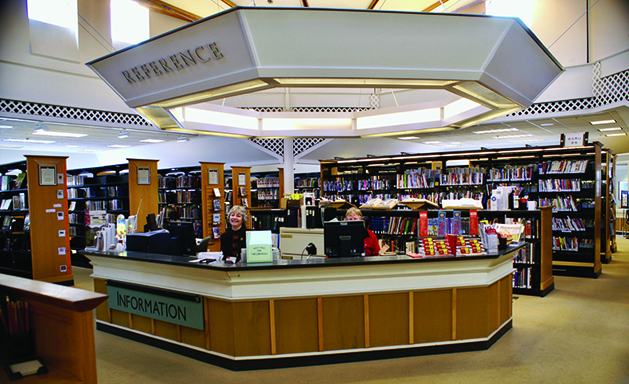
After initial approval in 1970, Plymouth Library had a fitful start. In a presentation Fischer delivered in 2011, she notes that in 1975 the Hennepin County Library (HCL) administration said a Plymouth Library was not in the immediate future. It took until 1990 for HCL to include the Plymouth location in its proposed capital budget for 1991. In 1992, the idea continued to gain momentum; a meeting between the Plymouth City Council and the board of HCL resulted in the city deciding to donate the site for the library at 15700 36th Ave. N.
Plymouth Library opened its doors on September 17, 1995, and Fischer was there from the beginning. Opening the new library was, “ … the highlight of my career as a librarian!” Fischer says. “The library director, Charles Brown, commented that in his 25 years of working with libraries, he had never seen as strong a community reaction to a library opening as he did in Plymouth,” she says.
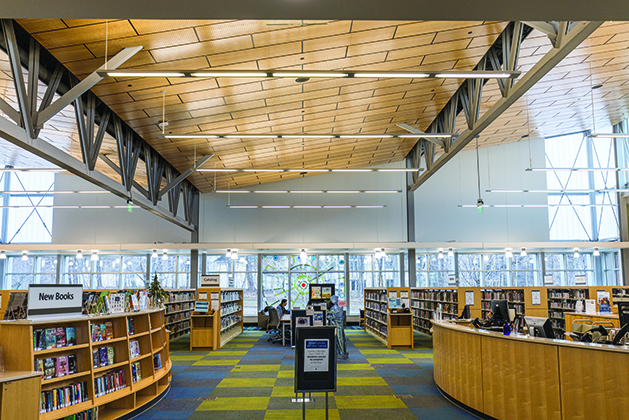
The instant popularity of the library meant it was too small from the day it opened, Fischer says, recalling that the original building didn’t have large enough meeting or study spaces to meet demand. By 2005, the library administration began looking for ways to expand it. Unlike the first building, the new library was quickly approved by 2006. In 2008, the old Plymouth Library building closed its doors for good, clearing the path for a new library building to take its place.
From its opening in 2010, the new Plymouth Library building was as busy as the last, but this building could accommodate the crowds. “The new library has a large teen area, more study rooms, more computers,” Fischer says. She also notes that the automated materials handling system and integrated service desk for both reference and circulation made a huge difference for the staff.
Plymouth Community Center
The library isn’t the only public resource in Plymouth that has been renovated to keep up with demand. Now, our tour heads into the present and points toward the future of Plymouth.
In October 1995, a month after the original Plymouth Library building opened to the public,
a group of senior citizens appeared before the City Council. Diane Evans, director of the Plymouth Community Center (PCC) from 2011 to 2022, says that this group of citizens prompted the City Council to form a task force which concluded that the 60,000 Plymouth residents would benefit from a multipurpose, multigenerational activity center.
Evans says Plymouth voters approved the use of $4.5 million in bonds to build an activity center and fieldhouse in May 1998. The originally named Plymouth Creek Activity Center opened in 2000, its 18,000 square feet dedicated to consolidating and expanding senior programs as well as providing an event space for the Plymouth community.

In 2006, an additional 11,000 square feet was added to the PCC through the build-out of the lower level, which now houses the Black Box Theater as well as conference rooms, meeting rooms and two small music rooms.
“The vision and design of the Plymouth Creek Activity Center began in 1997, with the ultimate goal of meeting the current and future recreation needs of all age groups for the next 15–20 years,” Evans says. Now, 20 years down the line, the PCC has undergone a new set of renovations to ensure it can continue to serve Plymouth’s growing community for the next 20 years to come.
The PCC Active Wing opened in January 2022, unveiling a new playground called the K.U.B.E as well as an indoor walking track, two gymnasiums and three fitness rooms. The second half of PCC’s renovation and restoration project, which began construction at the same time as the already unveiled Active Wing in August 2020, is set to open for the public by this July. Keep an eye out for the new Education Wing and renovated Event Wing this summer.
End of the Line ...
With our eyes on the future of Plymouth, it’s about time we disembark my history tour. I want to thank everyone who was so gracious with their time and knowledge for helping me discover the history behind these fixtures of the Plymouth community.








